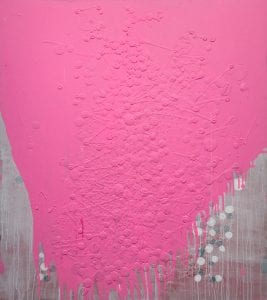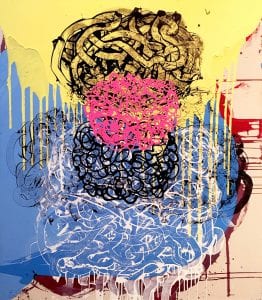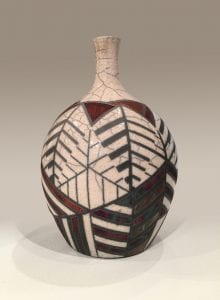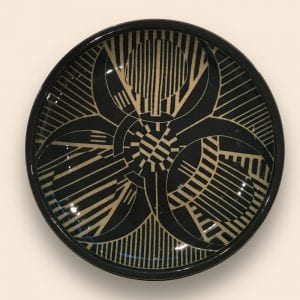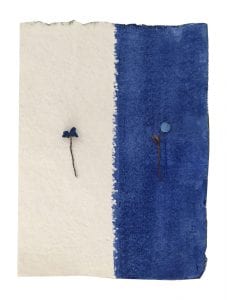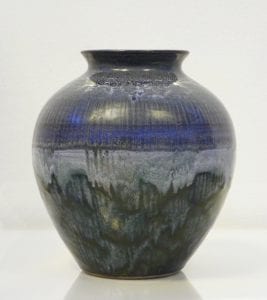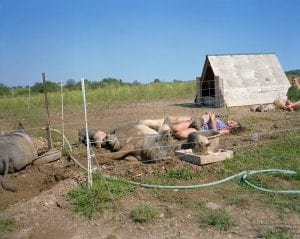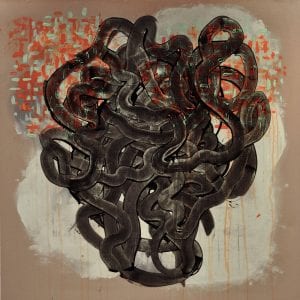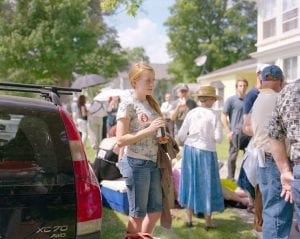
- This event has passed.
Area Artists 2017
January 25, 2017 - May 26, 2017
Free
Deborah Slahta, Judith Joy Ross, Ed Kerns, Pat Badt and Scott Sherk.
LUAG Main Gallery, Zoellner Arts Center
Area Artists is a biennial exhibition presenting the works of established artists and art educators of the eastern Pennsylvania region. The exhibition includes works by Deborah Slahta (ceramics), Judith Joy Ross (photography), Ed Kerns (Painting), and the collaborative team of Pat Badt (painting and book making) and Scott Sherk (sculpture and sound art).
History of the exhibition:
When I came to Lehigh in 1974, I felt a strong desire to connect the university exhibitions program with the community of local artists. I wanted to create opportunities for students to meet and talk with living, practicing artists—to be inspired by them and to learn from their processes. My hope was that students would get a sense of how artists think, how their ideas evolve, and that this would stimulate the students’ own process of looking, thinking, and making. Over the years, I have invited a number of local artist groups and solo artists to do exhibitions on campus. These have included local luminaries such as Richard Redd, Larry Fink, Ellen Giamportone, George Harvan, Scott Heist, Linda Cummings, Daniel Teresko, George Shortess, Harry Rinker, Fred Bees, Peggy Whitney Hobbs, Terry Niedzialek, Michael Kessler, Mark Beyer, Paula Verona, Lucy Gans, Al Erdosy, Robert Walch, Paul Harryn, Ben Marcune, Margaret & Joe Cantini, Martha Posner, and Steve Tobin along with collectives like the Lehigh Valley Craft Association and others.
In the mid-1980s, we inaugurated a biennial exhibition called Area Artists, featuring established and emerging artists and art educators of the eastern Pennsylvania region. Since that time, the exhibition has highlighted the variety and sophistication of artistic practice in the Lehigh Valley and beyond.
Participating artists have included: Ed Kerns, Ryland Greene, William Leidlich, James Carroll, Renzo Faggioli, Les Fletcher, Tom Short, Judith Taylor, Pat Badt, Doug Mason, Leonard Ragouzeos, Les Reker, Cheryl Dougan, Allen Moore, Barbara Thun, Peter Treiber, Susie Forrester, Curlee Raven Holton, Bruce Lanning, Mark Mahosky, Kristie Abel, Lydia Panas, Theo Anderson, Jett Ulaner Sarachek, Gerry Rowan, Daniel Scott Armstrong, Bill Kreider, Norman Sarachek, David Serra, Mark Wonsidler, Salma Arastu, Holly Trostle Brigham, Maureen Drdak, Gary Graves, Jeffrey W. Ludwig, Joseph Chapuk, Cheryl Agulnick Hochberg, Ed Nowak, Rigo Peralta, Winifred Helton-Harmon, Karina Aguilera Skvirsky, Amze Emmons, Anthony Rodale, Sandra Martin Ripa, Michael Burmeister, Greta Brubaker, Adriano Farinella, Daniel Paashaus, Krista Steinke, Angela Fraleigh, Jane Noel, Khalil Allaik, Wes Heiss, Judith Joy Ross, Deborah Slahta, and Scott Sherk.
Ricardo Viera
Director / Chief Curator
Lehigh University Art Galleries • Teaching Museum
Selected works from the exhibition:
More about the artists:
Deborah Slahta
Artist Statement. I work with clay and I play with fire. Inspired by the centuries-old tradition of vessel making, I create raku and stoneware pottery. There is an intimacy working with clay, a transformation via touch, giving life and spirit to the object. I use tape-resist, a technique I first experimented with close to forty years ago. Influenced by my love of geometry, marking and measuring with ruler and compass, the design begins with a line or a circle, evolving, repeating, filling the surface. Fascinated by fire, I find the drama and immediacy of the raku firing process contrasts sharply with the exacting and time-intensive process of taping and glazing each pot. Pulling a pot from the kiln red-hot, straw and sawdust bursting into flames, the smoke permeates the clay, coloring it from grey to black. In a split second, colors develop and sometimes disappear. The process is stopped by cooling the still hot pot with water. Extreme and at times uncontrollable, the magic of smoke and fire produces a moment flash-frozen in time. Bio. A lifelong resident of the Lehigh Valley, Deborah Slahta explores the vessel as a three-dimensional canvas, producing finely crafted raku and stoneware pottery. While attending Moravian College, Bethlehem, PA and graduating with a B.S. in Mathematics, she discovered a lifelong passion for clay. “I love the feel and smell of clay. With all the technology that surrounds us, I make things with my hands.” Mathematics and art have an ongoing historical relationship. Slahta utilizes geometric constructions to produce patterned motifs on the surface of her pots. Known for her precise, tape-resist designs, Slahta has embarked on new work which is a departure from well-defined divisions of space. Multiple layers of glaze flow and combine to create a more painterly approach. In addition to maintaining a studio at the Banana Factory, Bethlehem, PA, where she has been a juried resident artist since May 2000, Slahta teaches ceramics classes for adults, summer camps for children, and participates in after school programs for at-risk youth.
Ed Kerns
Artist Statement. The work loaned to this exhibit is a part of a larger collaborative project exploring the emergent, complex patterns and processes in visual structures. Working with neuroscientists and computational specialists I work to document the mind as pattern machine. As Jonah Lehrer (Proust Was A Neuroscientist, Mariner Books 2008) has said of the work, “The mind is a pattern machine. We see structure everywhere—in constellations of stars, the spots on dice, and the silhouettes of clouds—shaped by a multitude of forces we can vaguely comprehend. Although the universe is a noisy place, overflowing with randomness and contingency….we attempt to impose order on the mess of reality….we see in these deliberate abstractions we make the stuff of life familiar to us…an epistemic tension and paradox…” deep into the pattern. These paintings paint themselves by application of very simple rules and from this process new models of experience emerge that suggest a broad consilience of form and stochastic connectivity. Bio. Ed Kerns is an internationally recognized American abstract artist and educator. He has had over fifty solo exhibitions mostly in New York City and has participated in over one-hundred and seventy group exhibitions throughout the United States as well as in Japan, France, Germany, Spain, Italy, Mexico, Canada, Switzerland and China. Kerns started painting at a young age and achieved early notoriety. He attended the Richmond Professional Institute graduating at the top of his class. Kerns went on to study with Grace Hartigan at the Maryland Institute where he was a Hoffberger Painting Fellow. He worked for or studied with many of the New York abstract expressionist painters including Willem DeKooning, James Brooks, Ernest Briggs, David Hare and Phillip Guston. Kerns’ work has been reviewed in the The New York Times, The Village Voice, ARTFORUM, ART News, Arts Magazine and many other international journals. His work is represented in over sixty major museum and corporate collections. He is currently producing paintings using techniques that combine digital imaging with traditional techniques. His current works are largely the result of collaborations with neuroscientists, computational specialists, actors, poets and installation artists.
Pat Badt
Artist Statement. As a painter, I work with line, color and texture. String, along with the more standard tools of painting, are the instruments I use to paint. I create a linear web matrix that constantly locates the surface of the painting as a front-forward plane. This becomes a strategy to keep me present in the painting that accumulates over time to build the painting. I am attempting to make palpable visual moments. Just as direct experience becomes memory through the slow accumulation of time, I use paint to build surface over time, isolating events in a language of color. Study in Blue is a series of 33 works on paper with found and altered objects housed in a clam-shell box. The natural objects become islands on the surface of paint. Study in Blue was inspired by a 2015 artist residency in Valletta, Malta. Malta, an island country in the Mediterranean, is in many ways one continuous edge. Study in Blue explores different ideas of edge through abstract references to transitions. Bio. Pat Badt is a painter who also makes artist books and prints. She received her MFA from the University of Pennsylvania and her BA from the University of California, Santa Cruz. She has been the recipient of many awards and prizes including an NEA for painting and artist residencies at the SIMS residency Reykjavik, Iceland, the Bau Institute in Otranto, Italy and the Virginia Center for the Creative Arts. She has exhibited widely, including exhibitions in Brussels, New York, Philadelphia and Los Angeles. Her work is included in collections in the American Embassy in Riga, Latvia, the Ruth Hughes Collection of Artist Books at Oberlin College, Bryn Mawr College, and University of Tennessee-Knoxville. She is Emeritus Professor, Cedar Crest College. Pat Badt’s work is inspired by location, filtered through experience and sensibility. Her studio is in a white barn along the Jordan Creek, surrounded by apple orchards, low mountains and the convergence of two creeks. She also maintains a “pied-à-terre” studio in New York City. Collaboration. Scott Sherk and Pat Badt have collaborated on many projects through The Third Barn (www.thethirdbarn.com). The Katonah Museum of Art and The Lab Gallery in New York, NY are among the places where they have exhibited together. Their most recent piece, Cor + Som was an installation at Evoramonte Castle in Portugal. They have a sound and color piece in the permanent collection of the American Embassy in Riga, Latvia.
Scott Sherk
Artist Statement. As a sculptor, I have long been fascinated with the effects of the ethereal on one’s perception. I accidentally discovered sound when I bought an mp3 player several years ago, and I discovered that it could also record. While listening to my recordings, I realized that I could hear the size and characteristics of a space. As a sculptor, I was used to moving masses and forms around, but with sound I could carve into the space, itself, by manipulating the sound. When we hear a sound, we hear that event (handclap, whistle, foot-step) along with the space of that event. When we hear something, we hear space! I like to make field recordings of everyday places and events. Some of these recordings become source material. All places have distinct sounds and ambiences. These soundscapes becomes material, and as material they can be sculpted. This led more and more deeply into an experience of sculpture as a practice of deep sensitivity to subtle effects. Bio. Scott Sherk is a sculptor who often works with sound. He has exhibited widely including exhibitions at the Katonah Museum of Art, the Allentown Art Museum, the Kim Foster Gallery NYC, and the Leslie Cecil Gallery NYC. His solo exhibitions have been favorably reviewed by The New York Times and ARTFORUM. His sound work has been released on CD by 3Leaves, and/OAR, and net releases by Stasisfield and Wandering Ear. Scott Sherk is a Professor/Artist-in-Residence at Muhlenberg College where he has been a recipient of the Class of ‘32 Research Chair and twice the Hoffman Research Fellowship.
Judith Joy Ross
Artist Statement. I do not know. These photographs are from a series first exhibited in 2011 at Pace MacGill Gallery, NYC. The exhibition was entitled The Devil Today and Reading to Dogs. With this body of work, I wanted to help promote interest in our relationship with the natural world. I photographed people in relationships with animals and the natural world including folks protesting the misuse of the land. It was strikingly difficult to find people in the natural environment. In this culture, unless you yourself are a farmer, it is not common to see a person in the landscape. I have a home in the country and I never see my neighbors outside. For most people being outside is reserved for getting in the car and driving to another building. Today, most children do not even play outside. I could not find a single gardener to photograph. How did all those gardens get there? Plenty of folks mowing lawns however. There might be a law in fact that says don’t go outside unless you are going to mow that lawn. I must tell you how once at a boring dinner party, I tried to strike up a conversation with a man seated next to me. I had asked him if he had a garden and he answered “No I don’t have a garden, I loathe Nature.” As I found this a very interesting statement, I asked him to explain what he meant. He replied, “Nature, it’s all just so green and I don’t understand it.” So I tried to put myself in his place. How could he love something he didn’t understand? Here was this well-appointed man, a highly successful businessman who I imagined drove a luxury car, parked it in his luxury home and drove to his well-paying job. He was not a man much affected by the natural world and he wanted it that way. He wanted only to get into his air-conditioned car from his air-conditioned home to go to his air-conditioned job. Cement was his environmental constant. It kept him safe from the vicissitudes of the natural world but also from its profound joys. He had not noticed its beauty. His remark made me understand how it is that so many of us are detached from the natural world. Many of us have little familiarity for it. For many Americans, Nature has been civilized away and good riddance to it. The world itself does not tell us how to feel. Thankfully the Arts like Photography can point to what is important. In the face of what is likely the unspoken norm in America, the fact that many of us loathe or are indifferent towards nature, how can a few more photographs help promote an understanding of global warming? Can we turn the tide of our ignorance? I do not know. Bio. Judith Joy Ross holds a B.S. from Moore College of Art, Philadelphia; and an M.S. from the Institute of Design at the Illinois Institute of Technology, Chicago. She is the recipient of numerous honors, including a Guggenheim Fellowship (1985), a National Endowment for the Arts Fellowship (1986), a Charles Pratt Memorial Award (1992), and an Andrea Frank Foundation Award (1998). Ross’ photography has been exhibited internationally; most recently in a retrospective at Die Photographische Sammlung/SK Stiftung Kultur in Cologne, Germany; Tops Gallery, Memphis, Tennessee; and Deborah Bell Gallery, NY. Her work is in the permanent collections of the Museum of Fine Arts, Boston; The Metropolitan Museum of Art, NY; The Museum of Modern Art, NY; the Victoria and Albert Museum, London, among others. Ross is represented by Galerie Thomas Zander, Koln, Germany. She lives and works in Bethlehem, Pennsylvania.
